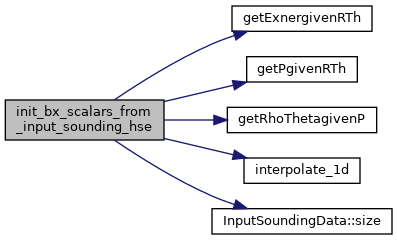ERF_InitFromInputSounding.cpp File Reference
#include <ERF.H>#include <ERF_EOS.H>#include <ERF_Constants.H>#include <ERF_Utils.H>#include <ERF_ProbCommon.H>
Include dependency graph for ERF_InitFromInputSounding.cpp:

Functions | |
| void | init_bx_scalars_from_input_sounding (const Box &bx, Array4< Real > const &state, GeometryData const &geomdata, Array4< const Real > const &z_cc_arr, const bool &l_moist, InputSoundingData const &inputSoundingData) |
| void | init_bx_scalars_from_input_sounding_hse (const Box &bx, Array4< Real > const &state, Array4< Real > const &r_hse_arr, Array4< Real > const &p_hse_arr, Array4< Real > const &pi_hse_arr, Array4< Real > const &th_hse_arr, Array4< Real > const &qv_hse_arr, GeometryData const &geomdata, Array4< const Real > const &z_cc_arr, const Real &l_gravity, const Real &l_rdOcp, const bool &l_moist, InputSoundingData const &inputSoundingData, const bool &l_isentropic) |
| void | init_bx_velocities_from_input_sounding (const Box &bx, Array4< Real > const &x_vel, Array4< Real > const &y_vel, Array4< Real > const &z_vel, GeometryData const &geomdata, Array4< const Real > const &z_nd_arr, InputSoundingData const &inputSoundingData) |
Function Documentation
◆ init_bx_scalars_from_input_sounding()
| void init_bx_scalars_from_input_sounding | ( | const Box & | bx, |
| Array4< Real > const & | state, | ||
| GeometryData const & | geomdata, | ||
| Array4< const Real > const & | z_cc_arr, | ||
| const bool & | l_moist, | ||
| InputSoundingData const & | inputSoundingData | ||
| ) |
Box level wrapper for initializing scalar data from input sounding data.
- Parameters
-
bx Box specifying the indices we are initializing state Array4 specifying the state data we are to initialize geomdata GeometryData object specifying the domain geometry inputSoundingData InputSoundingData object we are to initialize from
208 state(i, j, k, RhoTheta_comp) = rho_0 * interpolate_1d(z_inp_sound, theta_inp_sound, z, inp_sound_size);
215 // total nonprecipitating water (Q1) == water vapor (Qv), i.e., there is no cloud water or cloud ice
217 state(i, j, k, RhoQ1_comp) = rho_0 * interpolate_1d(z_inp_sound, qv_inp_sound, z, inp_sound_size);
@ z
AMREX_GPU_HOST_DEVICE AMREX_FORCE_INLINE amrex::Real interpolate_1d(const amrex::Real *alpha, const amrex::Real *beta, const amrex::Real alpha_interp, const int alpha_size)
Definition: ERF_Interpolation_1D.H:12
Referenced by ERF::init_from_input_sounding().
Here is the call graph for this function:

Here is the caller graph for this function:

◆ init_bx_scalars_from_input_sounding_hse()
| void init_bx_scalars_from_input_sounding_hse | ( | const Box & | bx, |
| Array4< Real > const & | state, | ||
| Array4< Real > const & | r_hse_arr, | ||
| Array4< Real > const & | p_hse_arr, | ||
| Array4< Real > const & | pi_hse_arr, | ||
| Array4< Real > const & | th_hse_arr, | ||
| Array4< Real > const & | qv_hse_arr, | ||
| GeometryData const & | geomdata, | ||
| Array4< const Real > const & | z_cc_arr, | ||
| const Real & | , | ||
| const Real & | l_rdOcp, | ||
| const bool & | l_moist, | ||
| InputSoundingData const & | inputSoundingData, | ||
| const bool & | l_isentropic | ||
| ) |
Box level wrapper for initializing scalar and hydrostatic base state data from input sounding data.
- Parameters
-
bx Box specifying the indices we are initializing state Array4 specifying the state data we are to initialize r_hse_arr Array4 specifying the density HSE base state data we are to initialize p_hse_arr Array4 specifying the pressure HSE base state data we are to initialize pi_hse_arr Array4 specifying the Exner pressure HSE base state data we are to initialize th_hse_arr Array4 specifying the base state potential temperature we are to initialize geomdata GeometryData object specifying the domain geometry l_gravity Real number specifying the gravitational acceleration constant l_rdOcp Real number specifying the Rhydberg constant ($R_d$) divided by specific heat at constant pressure ($c_p$) inputSoundingData InputSoundingData object we are to initialize from
AMREX_GPU_HOST_DEVICE AMREX_FORCE_INLINE amrex::Real getPgivenRTh(const amrex::Real rhotheta, const amrex::Real qv=0.)
Definition: ERF_EOS.H:81
AMREX_GPU_HOST_DEVICE AMREX_FORCE_INLINE amrex::Real getExnergivenRTh(const amrex::Real rhotheta, const amrex::Real rdOcp, const amrex::Real qv=0.0)
Definition: ERF_EOS.H:156
AMREX_GPU_HOST_DEVICE AMREX_FORCE_INLINE amrex::Real getRhoThetagivenP(const amrex::Real p, const amrex::Real qv=0.0)
Definition: ERF_EOS.H:172
Referenced by ERF::init_from_input_sounding().
Here is the call graph for this function:

Here is the caller graph for this function:

◆ init_bx_velocities_from_input_sounding()
| void init_bx_velocities_from_input_sounding | ( | const Box & | bx, |
| Array4< Real > const & | x_vel, | ||
| Array4< Real > const & | y_vel, | ||
| Array4< Real > const & | z_vel, | ||
| GeometryData const & | geomdata, | ||
| Array4< const Real > const & | z_nd_arr, | ||
| InputSoundingData const & | inputSoundingData | ||
| ) |
Box level wrapper for initializing velocities from input sounding data.
- Parameters
-
bx Box specifying the indices we are initializing x_vel Array4 specifying the x-velocity data we are to initialize y_vel Array4 specifying the y-velocity data we are to initialize z_vel Array4 specifying the z-velocity data we are to initialize geomdata GeometryData object specifying the domain geometry inputSoundingData InputSoundingData object we are to initialize from
Referenced by ERF::init_from_input_sounding().
Here is the call graph for this function:

Here is the caller graph for this function:
